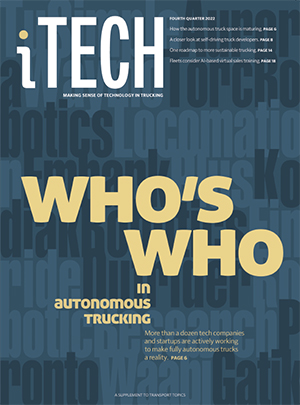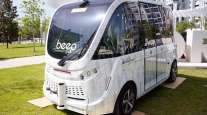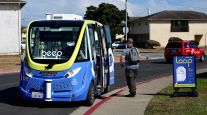7 Roadblocks to the Widespread Adoption of Autonomous Trucking
- Much of the self-driving industry’s research and development is focused on passenger cars. The success of autonomous trucking relies on its ability to leverage the same core technologies.
- In the future, the trucking industry will likely combine automation and human labor. Experts foresee a positive impact on working conditions for truck drivers.
- The trucking industry should expect to see self-driving technology hit the market gradually. Manufacturers must navigate new regulations, technical hurdles, and low consumer trust.
We live in an era of drone deliveries and self-driving robotaxis, but is America ready to embrace autonomous trucks on the freeway?
Even as Congress champions the benefits of self-driving technology, the trucking industry has lagged behind passenger vehicles. Manufacturing challenges, high costs, and regulatory hurdles — not to mention the enormous logistics involved in conducting road tests across all possible terrains and environments — have left many wondering if autonomous trucking will come to fruition in the next few decades.
Yet for those spearheading the research and development of autonomous trucks, realizing the vision will be worth the effort. According to Boris Sofman, the robotics innovator who now serves as the senior director of engineering and head of trucking at Waymo, self-driving software provides nearly unlimited potential for the trucking industry.
“Trucking is one of the most exciting industries,” Sofman explained in an interview with TT’s Seth Clevenger. “Compare [autonomous trucking] to what’s happened with important technologies like the computer or the internet. It doesn't just transplant certain segments of a sector with higher efficiency or cost dynamics. It completely enables you to rethink how you approach this really critical part of the economy.”
Automated vehicles could be a new stimulus to the overstretched supply chain, accelerating delivery times and improving working conditions for drivers. So what needs to happen for autonomous trucking to reach widespread commercial implementation? Here are seven challenges the industry has to overcome.
1. Self-driving software was built for cars, not trucks
A Class 8 tractor trailer with a gross weight exceeding 33,000 pounds is ten times the size of a small passenger vehicle — and that’s before loading its cargo. Trucks take more time and distance to stop, they require a larger turn radius, and they create significantly more force upon impact than a small car.

Who's Who in the Autonomous Space
►Overview of Self-Driving Truck Development
Company Sketches
Click the links to jump to profiles of autonomous companies.
Aurora | Waymo | TuSimple | Gatik | Locomation | Torc Robotics | Waabi | Einride | Plus | Embark | Kodiak Robotics | Robotic Research | Outrider | Pronto
Self-driving cars have primarily focused on short, low-speed routes in cities and suburbs. Amazon-owned Zoox runs a shuttle route between buildings, while startups like Cruise focus on ride-hailing services in city downtowns. Autonomous trucking, on the other hand, envisions longhaul highway routes with changing weather conditions and variable terrain, all while traveling at speed and potentially carrying hazardous cargo.
The early investment and product development in autonomous driving has largely been for all-electric passenger vehicles. Trucking needs to translate that technology — everything from sensors, lidar, and onboard cameras — to a new context with more variables and safety concerns. Driving systems need to be vehicle-agnostic, not built for a single car in a limited situation.
2. Trucks often lack redundant safety platforms
In terms of onboard computers and driver assistance technologies, the trucking industry is not as mature as the car industry. Sofman explained, “There are a few fundamental physical barriers to going driverless today.” Many trucks lack the redundant safety features built into cars that provide a fallback if the brakes or steering fails.
“[Operating with] no human driver is something that we won't do and nobody else should do without a system that has redundancy and safety features built in,” Sofman added. “On the passenger side, we've had multiple generations of vehicles that have done this.”
To solve this, Waymo has partnered with heavy-duty truck manufacturer Daimler to align software production with the development of hardware components. Until trucks have sufficient automated safety features, a truly driverless experience is out of the question.
3. Autonomous trucking has more use cases than robotaxis
Self-driving taxis can cover the same few city blocks day in and day out, creating a narrower subset of programming variables. Still, it’s difficult to account for every conceivable situation. Case in point — a Cruise robotaxi collided with a firetruck after entering an intersection on a green light.
Trucking, however, is a more specialized industry. Some companies focus on regional distribution routes, while others handle longhaul freight. Trucks can carry refrigerated, liquid, or flammable materials. Autonomous trucking software needs to accommodate a wide range of uses and variable permutations before scaling commercially.
4. Testing requires long highway driving
Not only do the use cases vary significantly, but trucks must also road test on highways instead of city streets. Unlike robotaxis that are implemented in specific urban markets, a practical application of self-driving trucking technology requires the ability to go hundreds of miles cross country.
Sofman pointed out that a flawless 30-minute run on a simple course is not enough to validate driverless technology, especially when it comes to trucks. “What really matters is how you quantifiably think about how you handle the one-in-a-million-mile rare scenario,” he said.
As unlikely as one in a million seems, millions of freight trucks each cover tens of thousands of miles per year in America. Self-driving developers need the expensive, time-consuming upfront investment of road tests to ensure their technology is highway-ready.
5. Deployment is logistically complicated
As marvelous as it sounds for an autonomous truck to cover 1,500 miles on I-10 from Los Angeles to Houston, there are practical concerns. How does an autonomous truck refuel? How would it navigate weigh stations or road closures?
Some companies have discussed creating transfer hubs where autonomous trucks could pick up and drop off their trailers. Human drivers would be responsible for first and last-mile routes on surface streets, including making deliveries to the loading dock. Not only will major distributors and trucking companies need to restructure their operations, but they will also need to meet the inevitable regulatory and legal requirements.
6. The trucking industry employs thousands of drivers
Critics of autonomous trucking often voice concerns that the technology will put drivers out of work. Yet the industry is currently facing a massive labor shortage with a poor work-life balance often cited as a reason drivers leave. Sofman was confident that self-driving trucks could actually improve working conditions and create new opportunities.
“The great thing about autonomous driving is that the types of routes that it's most conducive for are oftentimes the least pleasant ones to be a professional driver on,” Sofman said.
At least in the near term, however, longhaul routes will still require a human operator on board. To make autonomous trucking a reality, trucking companies will need to consider driver incentives in addition to investments in self-driving technology.
7. The public is still uncomfortable with self-driving trucks
It’s one thing to see a robotaxi circle a city block — and even on that, many Americans still feel skeptical. But it’s something else entirely to imagine a fully loaded 80,000-pound big rig changing lanes on a fast-moving freeway with no driver behind the wheel.
Sofman acknowledged that education and community partnerships will be keys to earning public trust. “Of course,” he added, “one of the best things you can do is actually experience the technology firsthand and take a ride.”
For many Americans, their first experience with driverless technology is more likely to involve a passenger car. Although trucking may have different goals than a self-driving rideshare, perhaps it’s the future widespread acceptance of robotaxis that will finally make autonomous trucks a reality.
This article is based on an episode of Roadsigns, a podcast exploring the trends and technologies that are shaping the future of trucking. Check out the website to catch past and future episodes.




